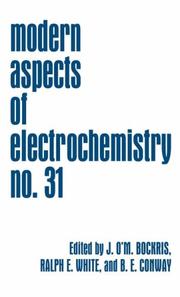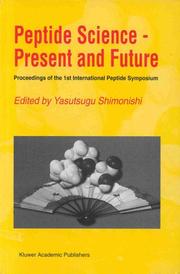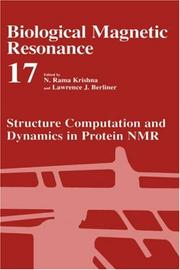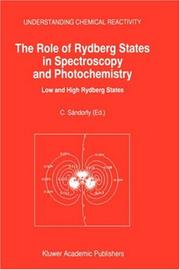| Listing 1 - 5 of 5 |
Sort by
|

ISBN: 1280205245 9786610205240 0306469103 0306456508 Year: 1999 Publisher: New York : Kluwer Academic/Plenum Publishers,
Abstract | Keywords | Export | Availability | Bookmark
 Loading...
Loading...Choose an application
- Reference Manager
- EndNote
- RefWorks (Direct export to RefWorks)
Prof. Jerzy Sobkowski starts off this 31st volume of Modern Aspects of Electrochemistry with a far-ranging discussion of experimental results from the past 10 years of interfacial studies. It forms a good background for the two succeeding chapters. The second chapter is by S. U. M. Khan on quantum mechanical treatment of electrode processes. Dr. Khan’s experience in this area is a good basis for this chapter, the contents of which will surprise some, but which as been well refereed. Molecular dynamic simulation is now a much-used technique in physical electrochemistry and in the third chapter Ilan Benjamin has written an account that brings together information from many recent publications, sometimes confirming earlier modeling approaches and sometimes breaking new territory. In Chapter 4, Akiko Aramata’s experience in researching single crystals is put to good advantage in her authoritative article on under- tential deposition. Finally, in Chapter 5, the applied side of electrochemistry is served by Bech-Neilsen et al. in the review of recent techniques for automated measurement of corrosion. J. O’M. Bockris, Texas A&M University B. E. Conway, University of Ottawa R. E. White, University of South Carolina Contents Chapter 1 METAL/SOLUTION INTERFACE: AN EXPERIMENTAL APPROACH Jerzy Sobkowski and Maria Jurkiewicz-Herbich I. Introduction.............................................. 1 II. Molecular Approach to the Metal/Solution Interface............. 3 1. Double-Layer Structure: General Considerations .......... 3 2. Solid Metal/Electrolyte Interface.......................... 8 3. Methods Used to Study Properties ofthe Metal/Solution Interface: Role of the Solvent and the Metal............. 15 The Thermodynamic Approach to the Metal/Solution Interface 35 III.
Electrochemistry. --- Electrochemical analysis. --- Chemistry. --- Chemistry, Physical organic. --- Analytical biochemistry. --- Chemistry, inorganic. --- Physical Chemistry. --- Analytical Chemistry. --- Inorganic Chemistry. --- Physical chemistry. --- Analytical chemistry. --- Inorganic chemistry. --- Inorganic chemistry --- Chemistry --- Inorganic compounds --- Analysis, Chemical --- Analytic chemistry --- Chemical analysis --- Chemistry, Analytic --- Chemistry, Theoretical --- Physical chemistry --- Theoretical chemistry --- Chemistry, Physical and theoretical --- Electrolytic corrosion.
Book
ISBN: 3540646213 3540692207 Year: 1999 Publisher: Berlin : Springer,
Abstract | Keywords | Export | Availability | Bookmark
 Loading...
Loading...Choose an application
- Reference Manager
- EndNote
- RefWorks (Direct export to RefWorks)
In recent years, a growing number of engineering applications of light weight and energy efficient plastics can be found in high quality parts vital to the func tioning of entire equipments and structures. Improved mechanical properties, especially balance of stiffness and toughness, are among the most frequently desired features of the new materials. In addition, reduced flammability is con sidered the single most important requirement for further expansion of plastics into large volume and demanding markets such as construction and mass trans port. Production of power cables also requires flame retardant cable jacketing plastics to replace or at least to reduce consumption of environmentally unsound PVC. The two principal ways to achieve the goals mentioned above include the development of completely new thermoplastic polymers and various modifica tions of the existing ones. Development and commercialization of a new ther moplastic require mobilization of large human and financial resources, the lat ter being within the range from $100 million to $10 billion, in comparison to $100 thousand to $10 million needed to develop and commercialize polymeric mate rial with prescribed end use properties using physical or chemical modification of an existing plastic. In addition, the various markets utilizing thermoplastics demand large flexibility in material properties with only moderate volumes, at the best.
fysicochemie --- Macromolecules --- Chemistry. --- Physical chemistry. --- Polymers. --- Condensed matter. --- Materials science. --- Polymer Sciences. --- Condensed Matter Physics. --- Physical Chemistry. --- Characterization and Evaluation of Materials. --- Thermoplastics. --- Surfaces (Physics) --- Physical organic chemistry. --- Polymers . --- Material science --- Physical sciences --- Chemistry, Theoretical --- Physical chemistry --- Theoretical chemistry --- Chemistry --- Condensed materials --- Condensed media --- Condensed phase --- Materials, Condensed --- Media, Condensed --- Phase, Condensed --- Liquids --- Matter --- Solids --- Polymere --- Polymeride --- Polymers and polymerization --- Chemistry, Physical organic --- Chemistry, Organic --- Chemistry, Physical and theoretical --- Fillers --- Thermoplastics

ISBN: 128004327X 9786610043279 0306468646 0792352718 Year: 1999 Publisher: Dordrecht ; Boston : Kluwer Academic Publishers,
Abstract | Keywords | Export | Availability | Bookmark
 Loading...
Loading...Choose an application
- Reference Manager
- EndNote
- RefWorks (Direct export to RefWorks)
In the late 1980s, Peptide Societies were established in Europe, the United States, and Japan, and more recently, in the Asian and the Pacific Rim regions including Australia, China, and Korea. At the time of the establishment of the American, European and Japanese Peptide Societies, the International Liaison Organizing Committee representing these Peptide Societies, along with the Australian Peptide Society, began discussions for holding international confer ences which would supercede or be held in lieu of the numerous individual meetings, held by the peptide societies of each individual country or region. The representative of the Chinese Peptide Society participated in these discus sion in the International Liaison Organizing Committee at the meeting of the American Peptide Symposium in Nashville, in June 1997. After lengthy discus sions over several years, we agreed to organize and host the International Peptide Symposium in Japan. The First International Peptide Symposium (IPS’97) was held on November 30–December 5, 1997, in Kyoto, and was co sponsored by four Peptide Societies. The attendance at this Symposium was 550 participants, including representatives from 32 different countries. We were very pleased with this outcome and anticipate an even larger attendance for forthcoming Symposia in future years. The revolution and advances in science and technology during the past two decades has caused traditional peptide chemistry to expand to peptide science, spreading from physical science to biology, pharmacology, and medicine.
Peptides --- Synthesis. --- Biochemistry. --- Bioorganic chemistry. --- Pharmacy. --- Chemistry, Physical organic. --- Chemistry, Organic. --- Protein Science. --- Bioorganic Chemistry. --- Biochemistry, general. --- Physical Chemistry. --- Organic Chemistry. --- Proteins . --- Physical chemistry. --- Organic chemistry. --- Organic chemistry --- Chemistry --- Chemistry, Theoretical --- Physical chemistry --- Theoretical chemistry --- Medicine --- Drugs --- Materia medica --- Pharmacology --- Biological chemistry --- Chemical composition of organisms --- Organisms --- Physiological chemistry --- Biology --- Medical sciences --- Bio-organic chemistry --- Biological organic chemistry --- Biochemistry --- Chemistry, Organic --- Proteids --- Biomolecules --- Polypeptides --- Proteomics --- Composition

ISBN: 0306459531 1280206551 9786610206551 0306470845 Year: 1999 Publisher: New York, New York : Plenum Press,
Abstract | Keywords | Export | Availability | Bookmark
 Loading...
Loading...Choose an application
- Reference Manager
- EndNote
- RefWorks (Direct export to RefWorks)
Volume 17 is the second in a special topic series devoted to modern techniques in protein NMR, under the Biological Magnetic Resonance series. Volume 16, with the subtitle Modern Techniques in Protein NMR , is the first in this series. These two volumes present some of the recent, significant advances in the biomolecular NMR field with emphasis on developments during the last five years. We are honored to have brought together in these volume some of the world s foremost experts who have provided broad leadership in advancing this field. Volume 16 contains - vances in two broad categories: I. Large Proteins, Complexes, and Membrane Proteins and II. Pulse Methods. Volume 17 contains major advances in: I. Com- tational Methods and II. Structure and Dynamics. The opening chapter of volume 17 starts with a consideration of some important aspects of modeling from spectroscopic and diffraction data by Wilfred van Gunsteren and his colleagues. The next two chapters deal with combined automated assignments and protein structure determination, an area of intense research in many laboratories since the traditional manual methods are often inadequate or laborious in handling large volumes of NMR data on large proteins. First, Werner Braun and his associates describe their experience with the NOAH/DIAMOD protocol developed in their laboratory.
Nuclear magnetic resonance spectroscopy. --- Proteins --- Structure. --- Radiology, Medical. --- Biochemistry. --- Chemistry, Physical organic. --- Imaging / Radiology. --- Biochemistry, general. --- Biological and Medical Physics, Biophysics. --- Atomic, Molecular, Optical and Plasma Physics. --- Physical Chemistry. --- Radiology. --- Biophysics. --- Biological physics. --- Atoms. --- Physics. --- Physical chemistry. --- Chemistry, Theoretical --- Physical chemistry --- Theoretical chemistry --- Chemistry --- Natural philosophy --- Philosophy, Natural --- Physical sciences --- Dynamics --- Chemistry, Physical and theoretical --- Matter --- Stereochemistry --- Biological physics --- Biology --- Medical sciences --- Physics --- Biological chemistry --- Chemical composition of organisms --- Organisms --- Physiological chemistry --- Radiological physics --- Radiation --- Constitution --- Composition --- NMR spectroscopy --- Spectroscopy, NMR --- Spectroscopy, Nuclear magnetic resonance --- Nuclear spectroscopy --- Knight shift

ISBN: 1280205458 9786610205455 0306469383 0792355334 Year: 1999 Publisher: Dordrecht, Netherlands ; Boston, Massachusetts : Kluwer Academic Publishers,
Abstract | Keywords | Export | Availability | Bookmark
 Loading...
Loading...Choose an application
- Reference Manager
- EndNote
- RefWorks (Direct export to RefWorks)
The aim of this volume is to offer a balanced overview of molecular Rydberg spectroscopy as it has developed over recent decades. Recent evolution has split Rydberg spectroscopy into two apparently distinct fields: the one concerns the low (n=3-5) Rydberg states, the other the very high (typically n>150) Rydberg states. The former is aimed at spectral levels where Rydberg, valence-shell, and intermediate-type states interact, with a variety of photochemical consequences. The latter considers states extremely close to the ionization limit, from whereionization is possible with a very slight amount of additional energy. Recently developed techniques make it possible to produce ions in well-defined electronic, vibrational and rotational states, including states resulting from spin-orbit or Jahn-Teller splitting. It is then possible to study the structure and reactions of such state-selected ions as well as those of the corresponding neutral molecules. These techniques amount to badly needed high resolution photoelectron spectroscopy.
Rydberg states. --- Spectrum analysis --- Photochemistry --- High resolution spectroscopy --- Technique. --- Chemistry, Physical organic. --- Physical Chemistry. --- Atomic, Molecular, Optical and Plasma Physics. --- Astrophysics and Astroparticles. --- Physical chemistry. --- Atoms. --- Physics. --- Astrophysics. --- Astronomical physics --- Astronomy --- Cosmic physics --- Physics --- Natural philosophy --- Philosophy, Natural --- Physical sciences --- Dynamics --- Chemistry, Physical and theoretical --- Matter --- Stereochemistry --- Chemistry, Theoretical --- Physical chemistry --- Theoretical chemistry --- Chemistry --- Constitution --- Spectroscopy, High resolution --- Resolution (Optics) --- Analysis, Spectrum --- Spectra --- Spectrochemical analysis --- Spectrochemistry --- Spectrometry --- Spectroscopy --- Analytical chemistry --- Interferometry --- Optics --- Radiation --- Wave-motion, Theory of --- Absorption spectra --- Light --- Spectroscope --- Rydberg atoms --- Rydberg series --- Atomic spectra --- Energy levels (Quantum mechanics) --- Qualitative
| Listing 1 - 5 of 5 |
Sort by
|

 Search
Search Feedback
Feedback About
About Help
Help News
News